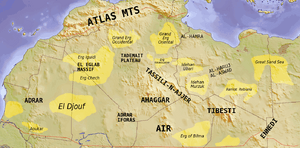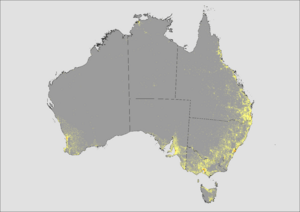List of uninhabited regions facts for kids
An uninhabited region is a place on Earth where no people live permanently. These areas can change over time. Sometimes, people move into places that were once empty. Other times, people leave areas that used to have residents.
Contents
What Does "Uninhabited" Mean?
It might seem easy to say if a place is "uninhabited," but it's actually a bit tricky!
Some groups of people, like nomads or hunter-gatherers, move around a lot. They don't stay in one spot all year. They use huge areas of land, but their population is very small. Even if these lands seem empty, they are important to these groups. They might use them for trapping, picking berries, or finding mushrooms. These places can also have special meaning to them.
Other places might not have people living there all the time, but many visitors come. For example, Jasper National Park in Canada had over 1.6 million visitors in 2020. But almost no one lives there permanently. So, it's not truly "uninhabited" if people are using it, even for visits.
Generally, only a few parts of Earth's dry land are so remote or have such harsh weather that no one uses them, even for part of the year. These include tiny islands, the driest parts of big deserts, very high mountains, and ice caps. Other areas are empty because laws protect them. These can be strict nature reserves or special zones where people are not allowed.
The "Nonecumene"
Geographers have a special word for all the uninhabited parts of the world: the nonecumene. It means the areas of Earth where no one lives.
Uninhabited Places in Africa
The Sahara Desert is the world's largest non-ice desert. It is not completely empty. Even remote areas like In Guezzam Province in Algeria have thousands of people. The only truly uninhabited parts of the Sahara are the ergs. These are huge fields of sand dunes. Even very hot, salty lake beds can have small communities nearby. For example, the Qattara Depression has a tiny village called Qara Oasis.
Uninhabited Places in Antarctica
Almost all of Antarctica is uninhabited. The only people there are scientists working at research stations.
Uninhabited Places in the Arctic
Many thousands of people live north of the Arctic Circle. Hundreds of thousands more live near the Arctic Ocean. The only truly uninhabited parts of the Arctic are the inner and northern coasts of Greenland. Many islands in the Canadian Arctic Archipelago are also empty. Some islands in Northern Norway and the Russian North are also uninhabited. Devon Island, in Canada, is the world's largest uninhabited island.
Northeast Greenland National Park is the world's largest protected land area. It has had zero permanent residents for many years. This is because the only mine in the area closed. However, even this remote area can have seasonal visitors. For example, 31 people and about 110 dogs were there during the winter of 2008.
Uninhabited Places in Australia
Even the driest parts of Australia have Indigenous communities. In 1984, a tribe that had not been in contact with modern society emerged from the Gibson Desert Nature Reserve. However, there are some true ergs (sand dunes and salt flats) in Australia that are completely uninhabited.
Uninhabited Places in North America
Besides the Arctic and Subarctic regions, few large areas in North America are truly uninhabited. Most of these are strict nature reserves or wilderness areas protected by law. Some of the largest include Improvement District No. 25, Alberta (about 4,600 square kilometers) and Tweedsmuir South Provincial Park in British Columbia (about 9,896 square kilometers).
Other Uninhabited Places
Here is a list of other places around the world that are uninhabited:
- Antipodes Islands
- Ashmore and Cartier Islands
- Bajo Nuevo Bank
- Baker Island
- Ball's Pyramid
- Balleny Islands
- Big Major Cay
- Bouvet Island
- Caroline Island
- Clipperton Island
- Elephant Island
- Elobey Chico
- Ernst Thälmann Island
- Much of Fiordland, New Zealand
- Goa Island
- Gough Island
- Hans Island
- Harmil
- Hashima Island
- Hatutu
- Heard Island and McDonald Islands
- The very high parts of the Himalaya mountains (and most other high mountains).
- Howland Island
- Ilha da Queimada Grande
- Inishark
- Jaco Island
- Jarvis Island
- Jong Batu
- Kahoolawe Island
- Kerguelen Islands
- Kingman Reef
- Little Colonsay
- Mborokua
- Minquiers and Ecréhous
- Melville Island
- Monomoy Island
- Perejil Island
- Pheasant Island
- Prince Edward Islands
- Navassa Island
- Nomans Land
- Paracel Islands
- Palmyra Atoll
- Redonda
- Round Island
- South Orkney Islands
- Spratly Islands
- Stirling Island
- Siwalik (the outer foothills of the Himalaya) and nearby areas in India, Pakistan, Nepal, and Bhutan. These areas are often empty due to diseases like malaria and dry soil.
- St Kilda
- Tetepare Island
- Tibet's very high mountain zones.
- Tinakula
See also
- Desert island
- List of ghost towns
- Private island
- List of largest protected areas





